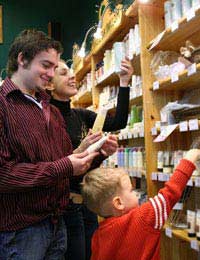How to Become Animal Free

If you’ve made the decision to live an animal free lifestyle the first step is to think about all the different ways animal products come into your life.
The main and most obvious one is the animal products we eat, but it can be easy to overlook the many other items in our homes which either include animal products, or have been tested on animals. These can be harder to identify, but not impossible, and once you’ve made the change to your thinking, it becomes easier to avoid animal products as you increase your awareness.
Animal Products in Unusual Places
It used to be the case that animal products were employed in the manufacture of many of the every day things around us. Think, for instance, catgut which was used to string tennis rackets and violins. (Although actually it came from sheep rather than cats.) Or ivory from elephants which turned up in all sorts of ornaments – not to mention, of course, piano keys.Today, advances in the manufacture of synthetic materials means that many of those items have been replaced with man made products, so we don’t have to make a point of buying ethical alternatives. Increased public awareness means that many companies, where possible, will avoid using animal products in their goods.
Animal Testing
The trickier area of consideration is for products that, whilst they may not contain ingredients originating from animals, have been tested on animals. It used to be standard practice that any product coming into contact with our skin had to be tested to ensure a level of safety and be certified for release on to the market. This led to those awful photographs we’ve all seen of dogs or rabbits shaved for skin testing or having products dripped in their eyes.Growing public awareness has led many manufacturers to find other ways of ensuring the safety of their products without the need for animal testing. The hard part is finding out which companies do still test their products on animals, or use ingredients that have been animal tested. A good first step is to check the website of the manufacturer of your favourite product. Chances are they will have a FAQ section, which will state their policy on animal testing. Unilever for example, who make some well known cleaning products, are quite honest about their policy on animal testing.
Make up and other beauty products like soap and shampoo may also have been tested on animals. Check the bottles for the manufacturer’s website and do some research. Alternatively, make the switch to green products. Almost all green beauty products include a no animal testing policy as part of their approach to being environmentally friendly, so they’re a safe bet if you need to pick something up in a hurry and don’t have time to check them out. Bear in mind that even if a company has a policy of not testing their own products on animals, they may use ingredients that other companies have tested. If you’re serious about cutting all animal products out of your life, you may need to spend some time getting to the bottom of which ones are ‘safe’.
Animal Free Food and Food for Animals
By far the easiest step to take to reduce your consumption of animal products is to cut them out of your food by becoming vegetarian or vegan. It’s usually easy to spot products containing meat or fish on the supermarket shelves, and if in doubt a tick from the Vegetarian Society is a sure fire guarantee.Be aware that some soups and stews may contain meat or fish stock, and puddings made from jelly probably include gelatine, which is also an animal product. Some sweets and biscuits also use gelatine. And some wines are clarified with animal products – particularly red wine.
If you’re very serious about going animal free, and you have a cat or a dog, you may have to consider if you also want to switch them to a vegetarian diet. It is easy to buy cereal and vegetable based pet food, but since cats and dogs are carnivorous by nature, you should discuss the option with your vet before making the change.
Fur Free Clothing
The final area where we tend to use animal products is with fur, leather and wool to make clothes, shoes, handbags and other accessories. All clothing is clearly marked with the materials used in its manufacture, however, and it’s simple to avoid those derived from animals, or to find alternative fabrics.Don’t let the apparent complexity of going animal free deter you from giving it a go. Treat it as a learning process and you’ll become an expert in no time.
Business Energy With a Difference
If you are looking for business energy or need advanced solutions like remote energy monitoring, new supplies, downgrading or upgrading capacity, have a no obligation chat with Purely Energy.
To find our more get in touch here. or call 0161 521 3400.








